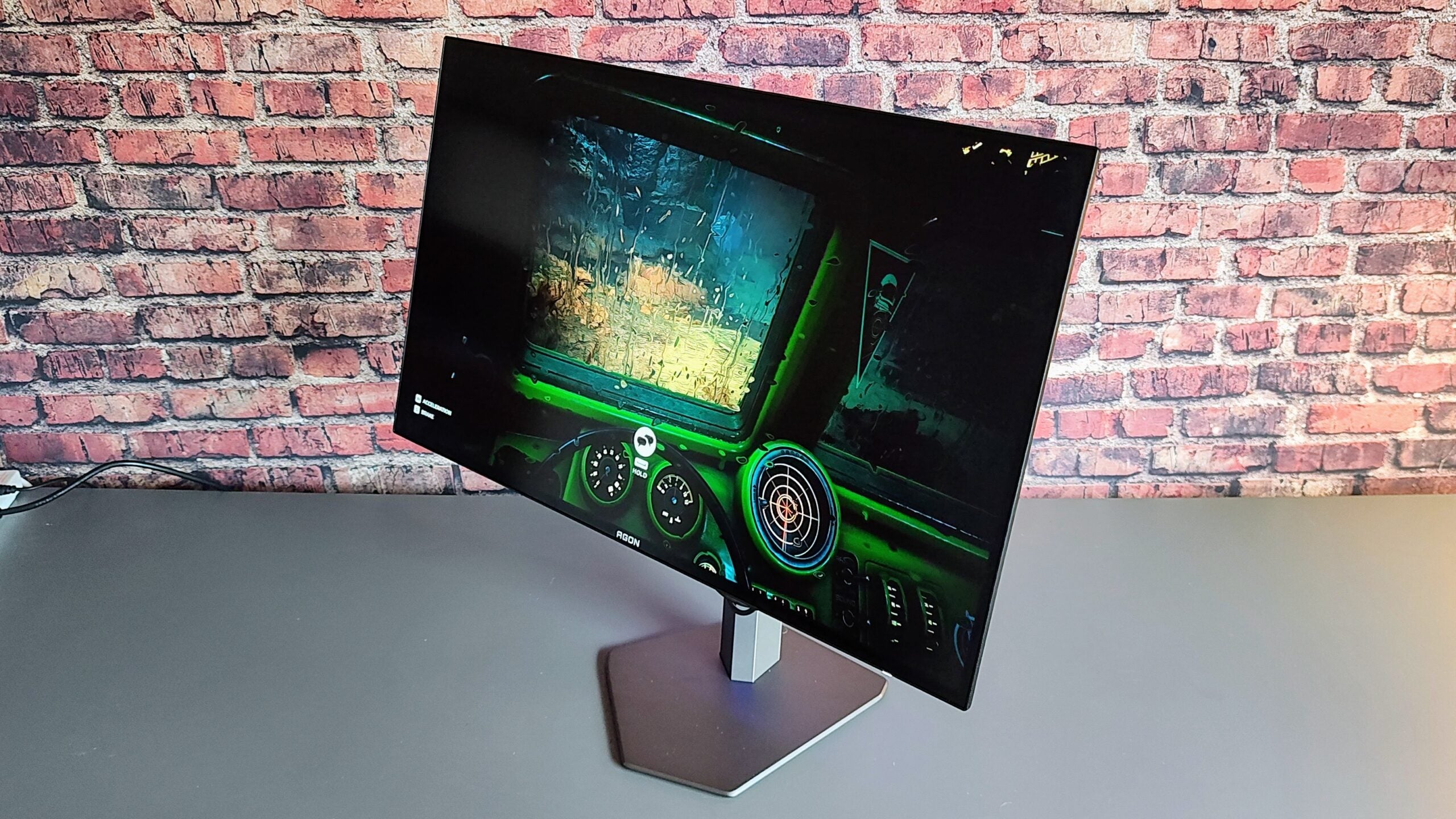Asus ROG Strix XG43UQ Review
A stunning, big-screen 4K gaming display
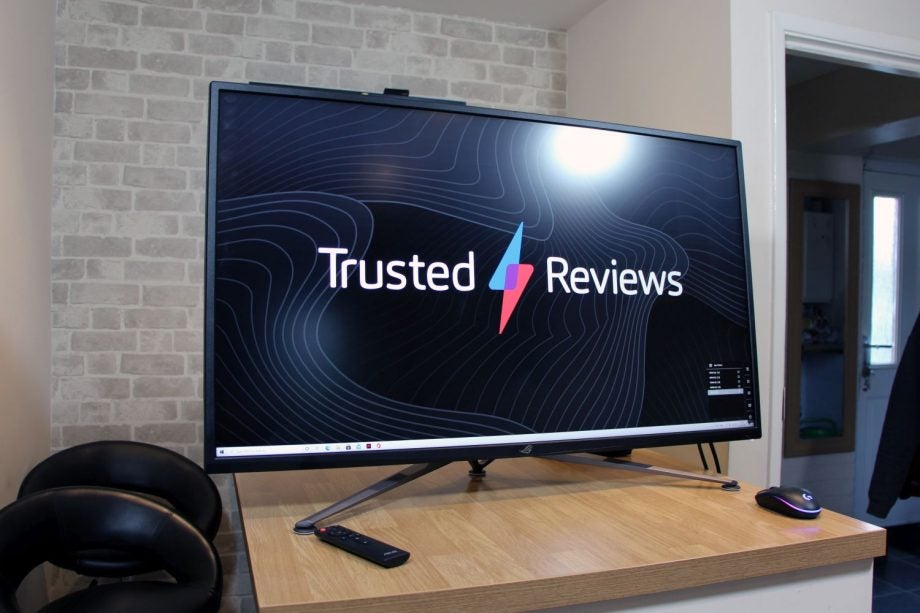
Verdict
The Asus ROG Strix XG43UQ gaming monitor has big, bold colours, fantastic contrast and a big-screen experience alongside great speakers. But it’s blurry, expensive and won’t suit every situation.
Pros
- Huge, immersive form factor
- Bold contrast and great colours
- Powerful, high-quality speakers
- Some future-proofed speakers
Cons
- Consistently a little blurry
- Won’t suit every situation
- BGR rather than RGB pixel layout
- Unsubtle HDR performance
Availability
- UKRRP: £1349
- USARRP: $1399
- EuropeRRP: €1349
Key Features
- TV-sized 4K gaming monitor:The 43in diagonal and 4K resolution deliver a big, immersive gaming experience.
- 144Hz refresh rate:The 144Hz refresh rate and AMD FreeSync Premim Pro ensure smooth mainstream gaming.
- Built-in speakers:The two 10W speakers are powerful, punchy and loud – perfect for bombastic gaming.
Introduction
The Asus ROG Strix XG43UQ is one of the most imposing gaming monitors you can buy today.
This vast 43in display is more like a TV than a PC display, and it’s designed for people who want to sit back and enjoy a big-screen experience – and those who want to switch between PC or console, or play games on the sofa.
It’s not a conventional gaming monitor, but it is impressive, with a specification that includes AMD FreeSync at 144Hz, a 4K resolution and DisplayHDR 1000. Is it one of the best gaming monitors you can buy today?
The Asus ROG Strix XG43UQ is a big display with a big price: in the UK it’s £1349, in the US it costs $1399, and it’ll arrive at a similar price in Europe.
The huge price also brings plenty of other displays into play, including widescreen panels like the AW3821DW. For this sort of cash, you could easily get a larger 4K OLED TV from any of the big brands or a large, curved widescreen display like the Alienware AW3821DW.
Design and features
- A big, bold and absorbing form factor and resolution
- Future-proofed console features and great speakers
- Plenty of connectivity, but not much adjustment
The Asus ROG Strix XG43UQ’s 43in diagonal is vast, and this unit has a 4K resolution and an underlying VA display with 10-bit colour. That’s solid: the 4K resolution only delivers a density of 102ppi, but that’s fine if you’re sitting further away – you’ll get the same crisp experience as a TV.
The 144Hz refresh rate is high enough to deliver smooth motion in any top-end single-player game and in mainstream esports titles. The Asus uses AMD FreeSync Premium Pro, which enables syncing alongside HDR, and it works with Nvidia graphics cards too.
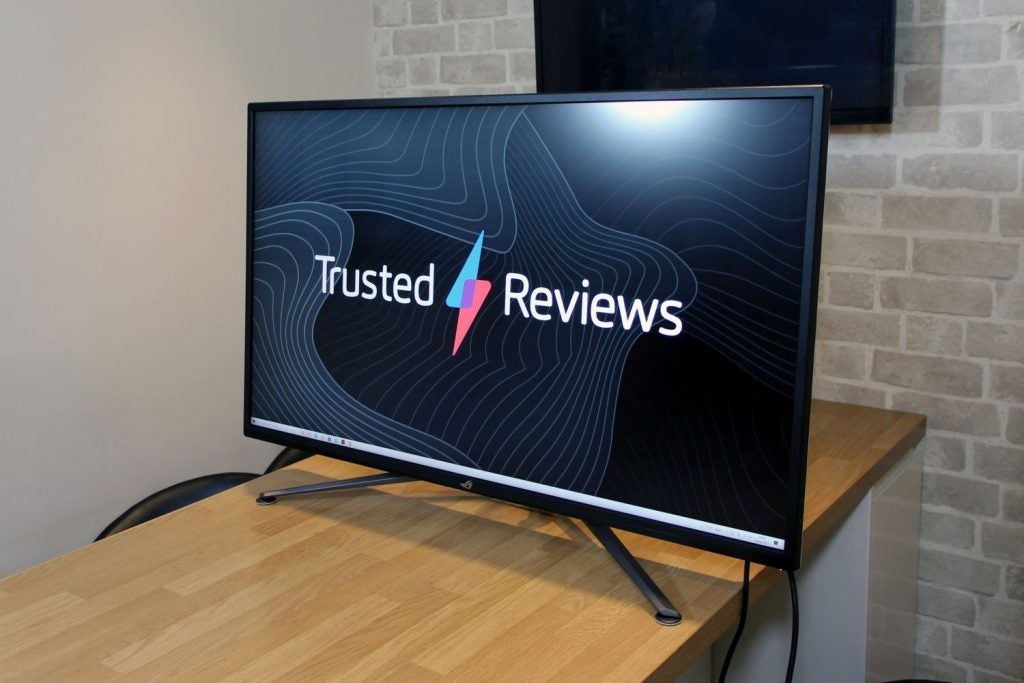
This panel also uses Asus’ own Extreme Low Motion Blur (ELMB) technology. It’s supposed to eliminate lingering ghosting and tearing and works with active sync. That’s better than Nvidia’s native Ultra Low Motion Blur (ULMB), which can’t work alongside syncing.
The Asus is rated for DisplayHDR 1000 which is among the highest certifications available for gaming displays, and better than the Alienware AW3821DWs DisplayHDR 600. It’s got a 1ms response time, which is good on paper, but it’s measured using MPRT rather than GTG – MPRT is the slower standard.
To run top games at 4K and decent refresh rates, you will need a powerful graphics card. If you want to max the panel out at 4K and 144Hz then you’ll need something like an Nvidia RTX 3080 or AMD RX 6900 XT. Even if you want to run less-demanding titles at 4K and 144Hz then you’ll need an Nvidia GeForce RTX 20-series or AMD Radeon RX 5700-series card or better, because the Asus uses Display Stream Compression – and only newer cards support that standard.
The Asus is designed for consoles, too, and it has plenty of muscle in this area. The XG43UQ has HDMI 2.1 ports, so in theory it’s capable of playing PS5 and Xbox Series X/S games at 4K and 120Hz. And, indeed, Asus will release an Xbox Edition of this display later in 2021.
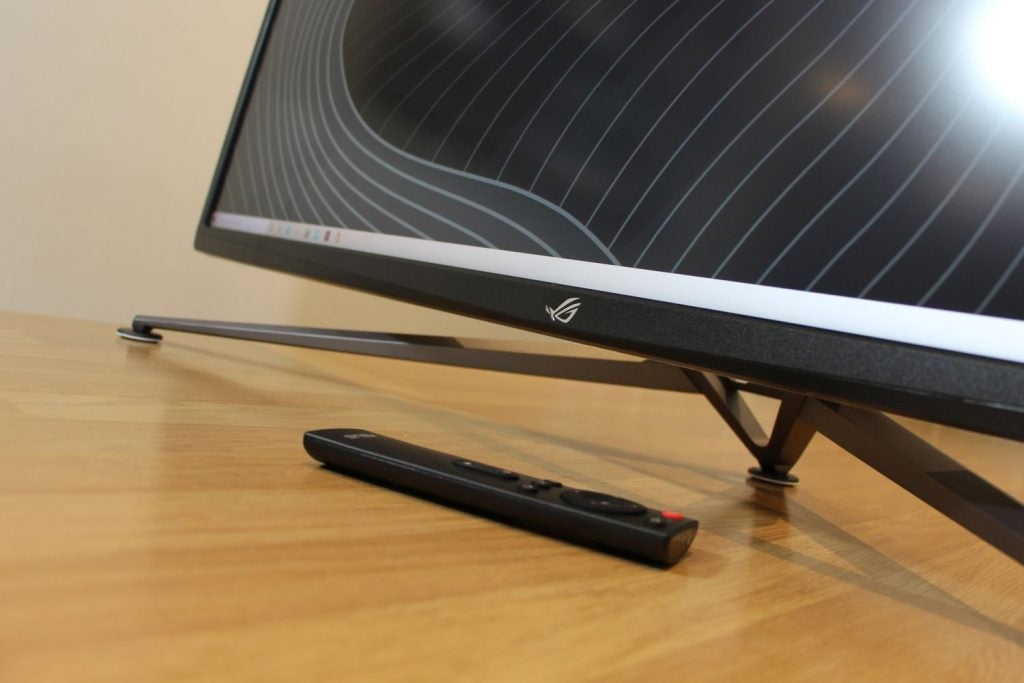
Playing at 4K and 120Hz is something for the future, though. Right now, only a handful of console games that run at 4K and 120fps. More games run at lesser resolutions, like 1080p and 1440p.
Of course, you can still use this display to run console games at 4K and lesser refresh rates, or at 120Hz and a lower resolution. But 4K/120Hz playback on consoles hasn’t come into its own yet. And, of course, the pricey Alienware display can’t handle consoles properly due to its wider aspect ratio and resolution.
The Asus sits on wide, metal legs, and can project an RGB LED ROG logo onto your desk or TV stand. Its surrounding bezel is wide, though, and the unit weighs 15.3kg and is 302mm deep, so it’s chunkier than the average flatscreen TV. It doesn’t have much adjustment, either: just 15-degrees of backwards-and-forwards tilt and support for 100mm VESA mounts. The Alienware is far better here.

On the Asus you’ll find two HDMI 2.0 ports, two USB 3.2 Gen 1 connections and an audio jack. Towards the rear are two HDMI 2.1 connectors and DisplayPort 1.4. That’s good, although this display has no USB-C ports. That’s a tad disappointing in 2021.
And, because the Asus is more like a TV than a gaming display, it’s got a pair of 10W speakers. They’re loud, powerful and punchy, with robust bass and decent quality throughout the range. They can’t quite match good TV speakers or a soundbar, but they’re not far away from that level of quality. They’re miles better than any other monitor speakers and easily good enough for gaming.
The Asus also has a remote control that adjusts the volume and settings. It’s also possible to control the Asus with DisplayWidget, which replicates the on-screen display in Windows. Both options are welcome, because the buttons on the back of this huge panel are difficult to reach.
Image quality
- Huge contrast, bold imagery and good colours
- Powerful but unsubtle HDR
- Enthusiasts won’t like the consistent blur during games
The Asus ROG Strix XG43UQ has fantastic contrast and bright colours, which means that you get huge punch, lashings of depth and loads of vibrancy. This display makes games pop. Out of the box, the Asus uses its racing mode, and this option delivers decent quality.
I used a colorimeter to record the performance results for the Asus ROG Strix XG43UQ. The brightness level of 479 nits looks bold, and the black point of 0.12 nits means a contrast level of 3991:1. That’s far better than any IPS display, including the panel in the Alienware, and it delivers punchy, vibrant images with loads of depth, albeit with less of the nuanced realism you’d expect from an IPS.
The Delta E of 2.12 is decent and its colour temperature of 6110K is solid, too. Neither figure is perfect, with the latter proving a little warm, but neither figure affects gameplay. Those results are joined by an sRGB coverage level of 98.9% with a volume of 129.3%, which means that this panel can display every shade required for mainstream games with gusto.
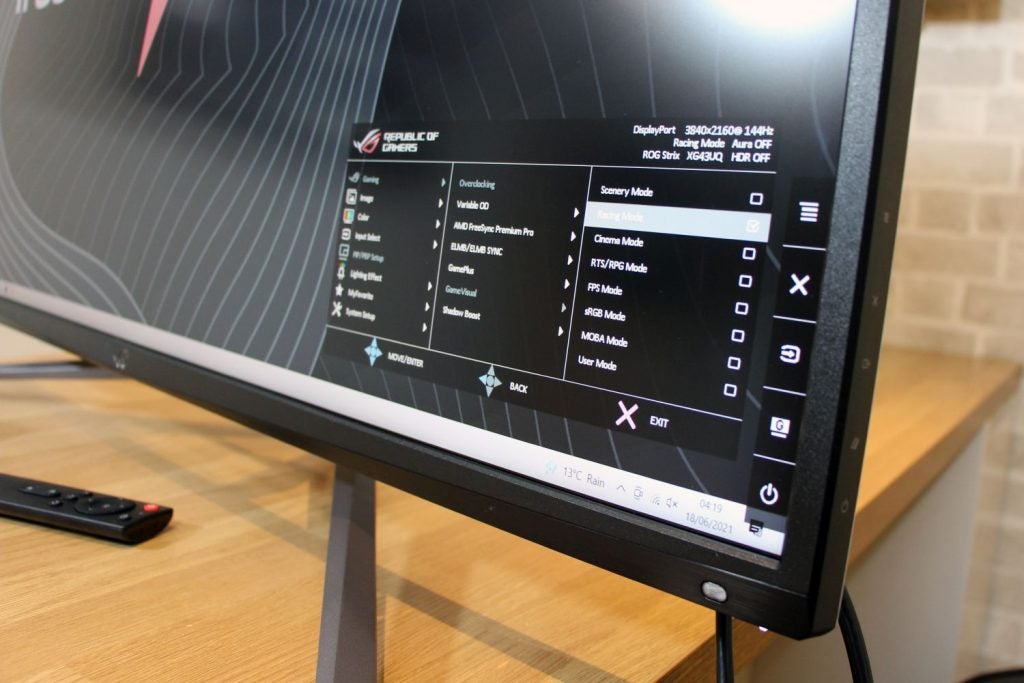
When operating in SDR mode, the Asus achieved a maximum brightness of 909 nits. The panel’s contrast and colour accuracy remained consistent here, and that bodes well if you want to dial the display up for a bolder experience from across the room. Similarly, contrast and quality remained consistent at more modest brightness levels too.
The only issue I found with these initial tests came in the uniformity benchmark. While the Asus retains its backlight strength towards the centre, it loses 20% of that strength in the corners. This won’t impact on gameplay too much, but it could be better.
I wouldn’t recommend switching the Asus away from its default Racing mode, either. The FPS, MOBA and RTS/RPG modes all ruin the Delta E, so colours look worse. Indeed, the only option I’d recommend is the Cinema mode, which improved the colour temperature and Delta E results to 6345K and 1.17 respectively to provide a more realistic image.
The Asus’ big, bold experience continued with HDR activated. With HDR activated the panel hit a peak brightness of 1070 nits and a black point of 0.2 nits, which means a fantastic contrast ratio of 5350:1. The Asus rendered 91.5% of the HDR-friendly DCI-P3 gamut. Those figures deliver a decent HDR experience, with bold high points and loads of depth. It’s far better than the Alienware.
It’s not infallible, though. For all of its punch the Asus remains edge-lit, so it doesn’t have the extra dimming zones used on the best HDR TVs. So, while the Asus is bold, it’s not subtle.
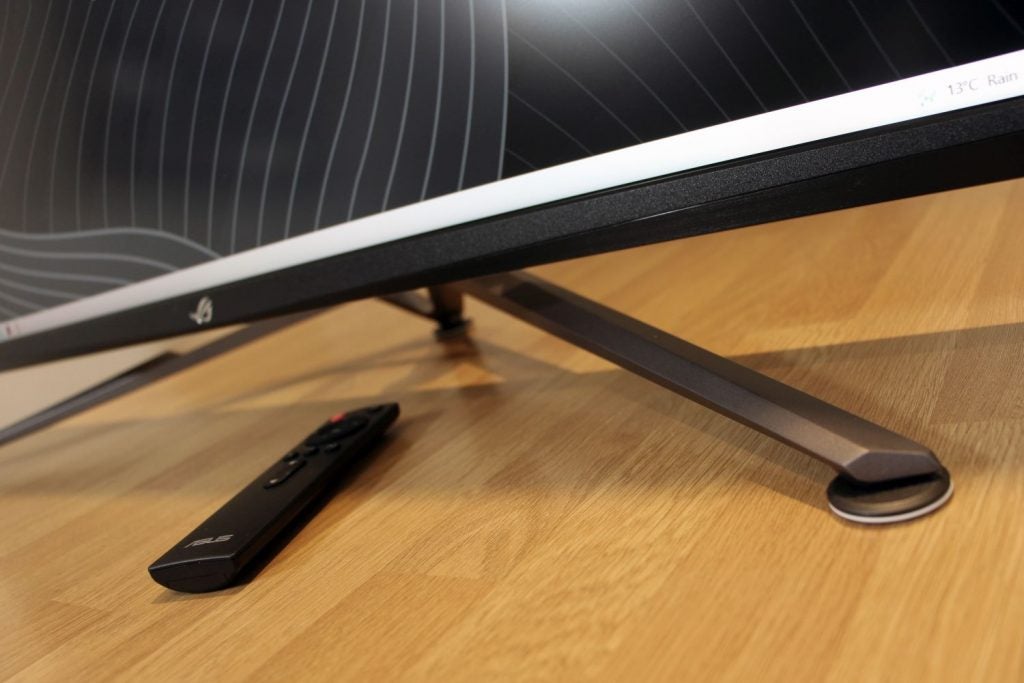
Settling down to play games also reveals a few quirks and limitations from the Asus’ blend of features. Take ELMB: it only runs in one of three horizontal bands across the display rather than the entire panel. That’s not ideal, and upping the ELMB clarity also reduces the display’s brightness.
Those clarity levels have issues, too. At the display’s default level of 3, there’s a little bit of ghosting and haloing around moving objects, and they’re still a little blurry. At level five, objects are crisper, but the ghosting and haloing is crisper, too – so it’s more obvious. It’s a shame, because these clarity levels do make images sharper to varying degrees. But when those sharper objects are followed by varying levels of ghosting and haloing, too, they’re not worth using.
Indeed, there’s little difference between ELMB and the Asus’ conventional Overdrive settings: both make things crisper, but both suffer from some ghosting and haloing. And, with Overdrive being applied across the whole display rather than in bands, that’s what I’d use instead.
Happily, you don’t have to deploy either mode to enjoy games. Conventional syncing delivers enough smooth imagery to make games look decent, and the Overdrive and ELMB options only have a minor impact on clarity in the grand scheme of things. If you leave those modes off, there is blur when gaming, but you’re barely going to notice it when you’re playing from across the room. The blurring is the sort of thing that will bother enthusiasts more than casual players.
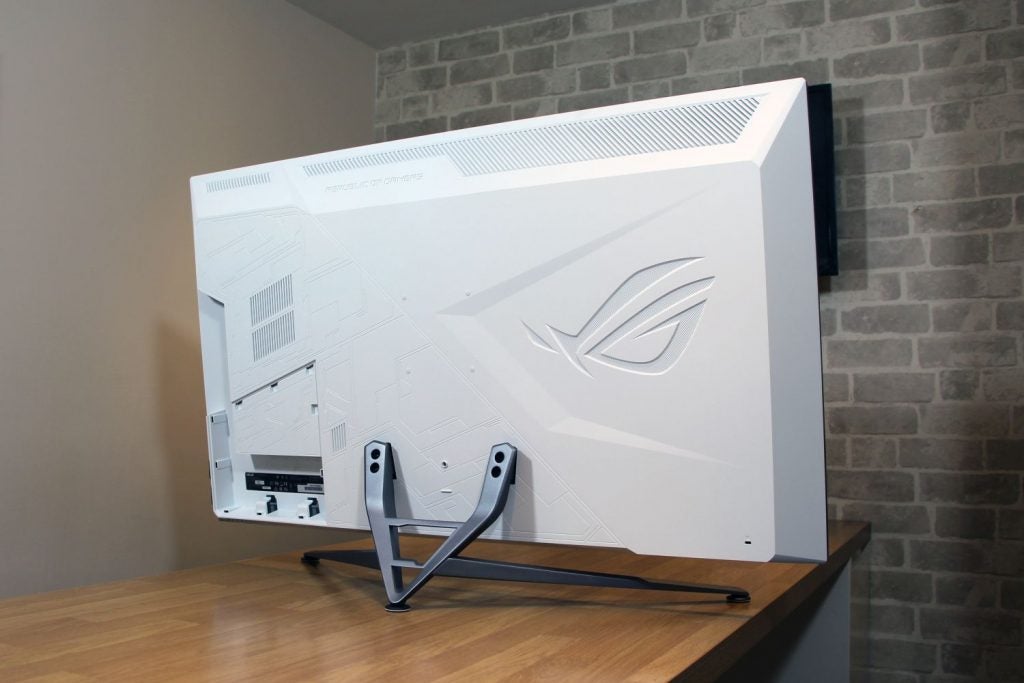
Also consider the response time. While 1ms sounds great on paper, MPRT is slower than GTG, and it also contributes to a little extra blurring. It’s not ruinous during mainstream gameplay, but don’t be fooled into thinking you’re getting the 1ms response that’s evident on the best esports panels.
Enthusiasts should also consider that this panel uses an underlying BGR sub-pixel layout. If you look closely at the text, that means it’s not quite as crisp as it would be on the average PC display – the same happens if you examine text on a TV from a couple of inches away.
In everyday use it’s not a hindrance, and you’ll be using Windows’ scaling settings to make everything more legible anyway – ramp that up to 150% and everything is crisper and cleaner. Asus has also applied some image processing to make text crisper on this display. It makes the fonts crisp and sharp, although some enthusiasts won’t like that extra intervention.
The XG43UQ also looks out of place in the wider market. If you want games on a traditional PC setup, this money will get you a faster, crisper display – and 43in is just too big. If you want to play from the sofa, you could buy a bigger 120Hz OLED TV that’ll have better speakers and contrast.
It leaves the XG43UQ in an odd spot. It’s an impressive display that makes games look fantastic, and if its size suits your situation then it’s an excellent option for vibrant, bold mainstream gaming. But for most PC and living room gamers, there are better ways to spend your cash.
Best Offers
Should you buy it?
You want a loud, vibrant big-screen gaming experience:
Its size and vibrancy mean that this display works very well for playing mainstream single-player games and esports titles on PCs and consoles. It’ll fit well in living rooms or bedrooms.
You’re searching for enthusiast-level quality:
This panel never really escapes blurring, no matter what settings you use. Enthusiasts will notice, and the blurring and mid-range refresh rate means esports fans will want a smaller, faster and crisper display.
Final Thoughts
The Asus ROG Strix XG43UQ uses its brilliant contrast and decent colours to deliver a bold, vibrant gaming experience alongside powerful speakers and future-proofed features, but it’s not sharp or fast enough for top-tier esports and it won’t suit every situation due to its huge size.
FAQs
The Asus has a one-year warranty.
Yes, the Asus ROG Strix XG43UQ features an FPS counter.
Yes, Nvidia graphics cards do support this feature.
Trusted Reviews’ test data
Specs
Jargon buster
Nits
The brightness level of a display. 300 nits is regarded as the minimum target for high-end screens.


